Topics List
Feb. 3, 2016 Updated
ASTRO-H Press Kit
|
As the launch day approaches, JAXA has released the press kit for the X-ray Astronomy Satellite “ASTRO-H”. It covers ASTRO-H’s satellite and mission overview, scientific missions, and observation instruments. Please have a look. |
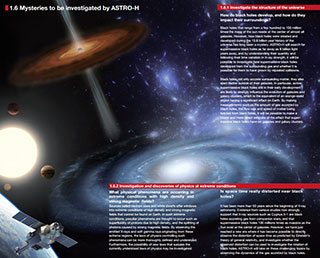 |
|---|
Jan. 21, 2016 Updated
ASTRO-H’s development and preparation status is updated on the ASTRO-H diary site
|
Aiming at the launch and success of the mission, for some years the Astro-H team members have been hard at work at research and development, making steady progress. They have faced many tough obstacles along this long road. They have had many moments of success. |
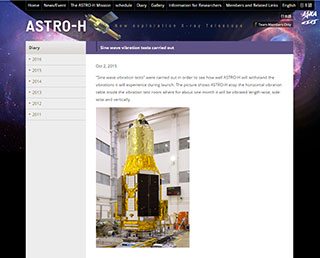 |
|---|
Jan. 12, 2016 Updated
ASTRO-H Satellite Shown to the Public
|
On the day marking exactly one month to launch, the ASTRO-H spacecraft was exhibited to the public at the Tanegashima Space Center. Many questions were asked both about the science goals of ASTRO-H and about its engineering. |
 |
|---|
Dec. 11, 2015 Updated
X-ray Astronomy Satellite “ASTRO-H” to be launched on Feb. 12
|
The new generation X-ray astronomy satellite ASTRO-H is set for launch on February 12 (Fri.), by the H-IIA Launch Vehicle No. 30 from the Tanegashima Space Center. JAXA will broadcast a live launch report on the launch day. We will announce more details later. Please look forward to the launch! |
 |
|---|
Dec. 2, 2015 Updated
ASTRO-H press day
|
The X-ray Astronomy Satellite “ASTRO-H” was revealed to the media on Nov. 27 at the Tsukuba Space Center. |
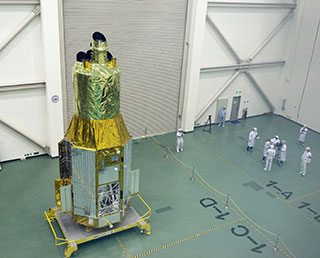 |
|---|
Nov. 2, 2015 Updated
ASTRO-H sinusoidal vibration test
|
The sinusoidal vibration test of the X-ray astronomy satellite “ASTRO-H” was held between Aug. 29 and Oct. 2 at the Tsukuba Space Center. The sinusoidal vibration test aims at two major evaluation objectives, namely evaluating dynamic characteristics of a satellite structure and assessing its strength by loading vibrations equivalent to that at the launch. |
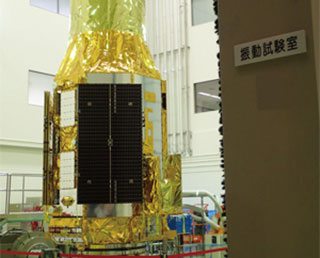 |
|---|
Aug. 3, 2015 Updated
ASTRO-H thermal vacuum test
|
The thermal vacuum test was held for the X-ray Astronomy Satellite “ASTRO-H” between June 24 and July 9 in a 13-meter chamber at the Tsukuba Space Center. The purposes of the thermal vacuum test are to verify the thermal model by exposing a satellite to the vacuum and thermal environment, and to confirm the function and performance of observation instruments in the on-orbit environment through an electric test. |
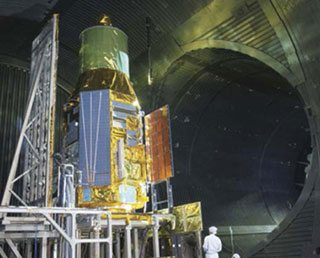 |
|---|
Apr. 21, 2015 Updated
Soft Gamma-ray Detectors (SGDs) installation on ASTRO-H completed
|
Two Soft Gamma-ray Detectors (SGDs), which successfully went through the thermal vacuum test and the cooling test, were installed onto the ASTRO-H. The photo shows the SGD2 on the ASTRO-H with a debris cover and a radiator. A golden color MLI (multi-layer insulation) will wrap them so that they will not be seen from outside. |
 |
|---|
Jan. 25, 2015 Updated
Thermal vacuum test for Soft Gamma-ray Detectors
|
The Soft Gamma-ray Detectors (SGD) to observe the soft gamma-ray region of 60 to 600 keV are under the thermal vacuum test in the 8-meter chamber at the Tsukuba Space Center to confirm their thermal design. |
 |
|---|
May 29, 2014 Updated
First Integration Test for ASTRO-H (for XRT)
|
As manufacturing of two Hard X-ray Telescopes (HXTs) and two Soft X-ray Telescopes (SXTs) has been completed and their performance has been confirmed, they are going to be subject to the first integration test. During the test, the telescopes will be mounted on an optical board to make sure that there is no interference with other structures or the satellite bus as well as that no problems arise with operations for controlling the telescope position or angle and operation tools. |
 |
|---|
Mar. 26, 2013 Updated
ASTRO-H development status
Aug. 10, 2012 Updated
Satellite development going well: Development test status
Mar. 15, 2010 Updated
ASTRO-H passed the basic design review, new logo published
|
On May 13 and 14, 2010, the basic design review was held for the ASTRO-H, and the satellite passed the examination. We are moving to the detailed design phase. To celebrate this opportunity, we revised the official logo mark for the ASTRO-H and published it on Feb. 25. The launch of the ASTRO-H is coming closer, and we are working hard for the project to proceed smoothly. Your support will be very much appreciated. |
 |
|---|
Oct. 28, 2009 Updated
SRON-JAXA agreement on Space Science
|
On October 28th, 2009, SRON Netherlands Institute for Space Research and JAXA signed a cooperative framework agreement with the aim of promoting joint activities in the field of space science in the presence of Dr. De Heer, the Ambassador Extraordinary and Plenipotentiary of the Kingdome of the Netherlands to Japan, and Dr. Tachikawa, the President of JAXA. |
 |
|---|
This entry passed through the Full-Text RSS service – if this is your content and you’re reading it on someone else’s site, please read the FAQ at fivefilters.org/content-only/faq.php#publishers.
Comments are closed.